War Among The Ruins
During the First World War, the deliberate destruction of western Europe's medieval heritage changed how people thought about their nations' pasts. Heritage tourism is one of the war's lesser-known legacies.
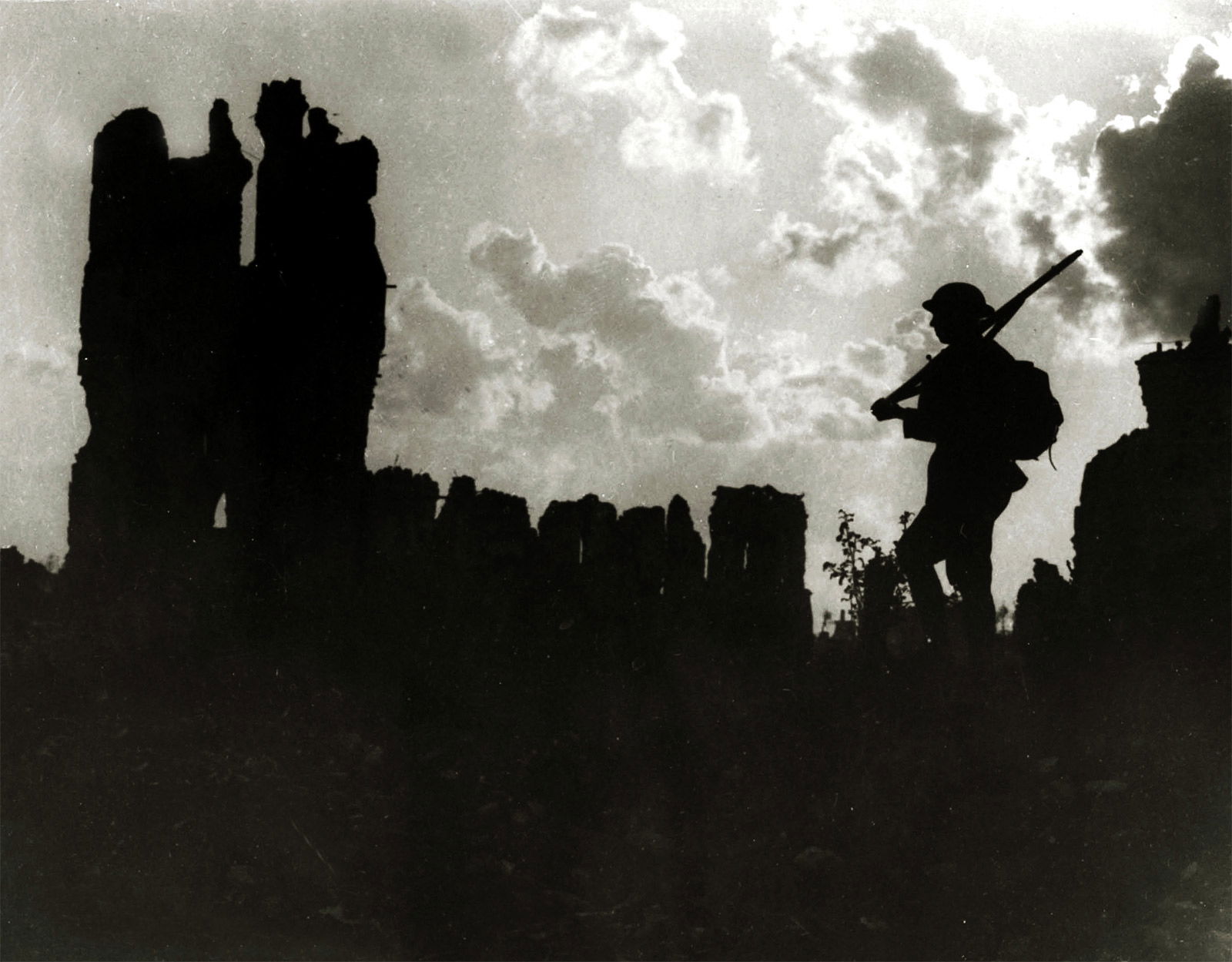
Throughout the four years marking the centenary of the First World War, we have seen a succession of sombre events marking its many major and minor tragedies. Among the most poignant datelines are those recalling a litany of medieval landmarks that fell along the frontline almost from the opening hours of the war: at first, simply shattered by the German army's rapid advance and then steadily eroded by mutually destructive attrition. Treasured symbols of its commercial and cultural power in the later Middle Ages, Belgium's heritage churches bore the full ferocity of the first salvoes. Liège's late Gothic cathedral of St Paul came under enemy bombardment on the second, sweltering day of the war and, following the fall of the medieval walled city of Namur on 23 August 1914, the German Third Army took Dinant on the same day. There they toppled the distinctive Reformation-era pyriform dome of its collegiate church, an act of destruction that was eclipsed by the massacre of 600 townspeople. No doubt in the next four years most of the major milestones in the conflict will be marked, but, perhaps increasingly, we will also remember and reflect on those experiences – mechanisation, civilian bombardment – which, after the passage of a century, we can see more clearly represent moments of great cultural transformation.
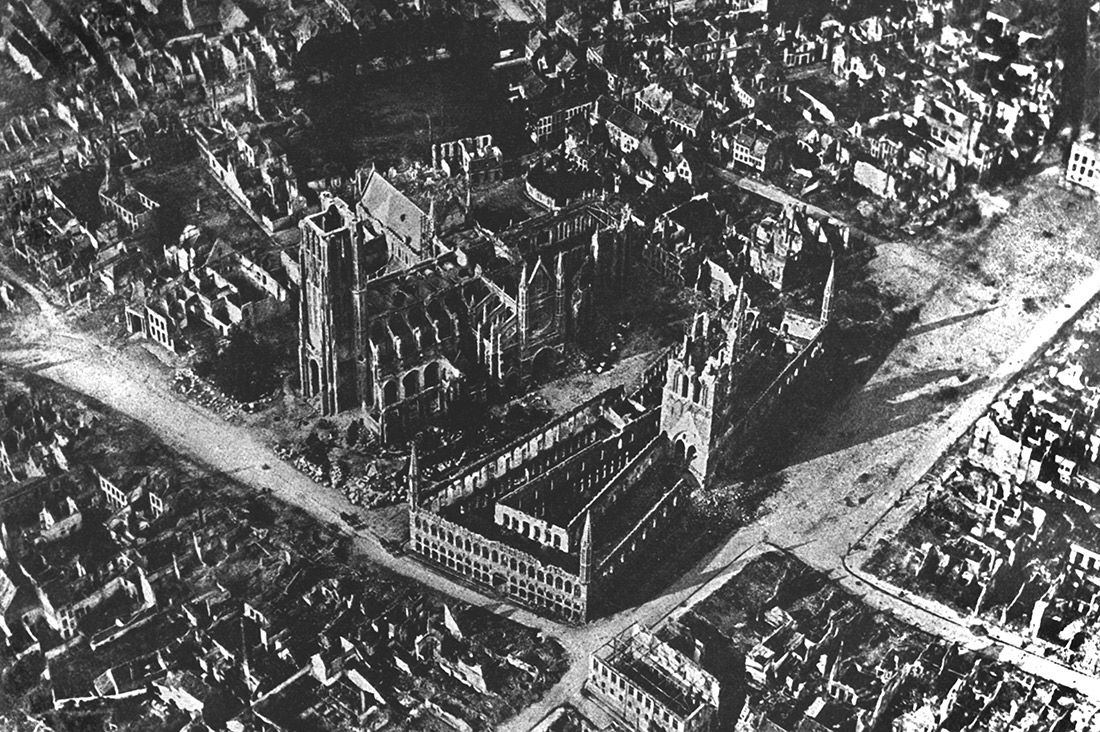
The first engagements by the German army with French and British forces – Mulhouse (7-19 August), Charleroi (21 August), Mons (23 August) and Le Cateau (26 August) – for the most part skirted or spared such landmark sites, including the baroque cathedral at Belfort. However, as the Germans reached further into France, other – and, in the scale of medieval artistry, arguably greater – townscapes came under threat. The desperate retreats of late August drew the line of the emerging Western Front back as far as Arras, a medieval city rich in classical refinements, and then to the uncompromisingly gothic St Quentin. While the 'miracle of the Marne' assured lasting protection for the Île de France and Paris, the cost was to be a near-constant barrage along a chain of northern cities, each one celebrated for its medieval architecture and art.
A presage of what was to follow in the four years of war was offered at Reims, scarcely six weeks after the conflict began. On Saturday 19 September a shower of German incendiaries set the 13th-century cathedral ablaze. In the stillness of a misty autumn twilight, bystanders paused aghast at the edge of the Place du Parvis as fire seized the roof timbers and the scaffold, which, by a fateful irony, still surrounded the northern tower of the west front after a stint of restoration work. The fire reached such intensity in the hours that followed that it softened the mortared joints of the statues covering the facade. Suddenly, the sculpted head of the Smiling Angel – le sourire de Reims – broke from its shoulders and fell.
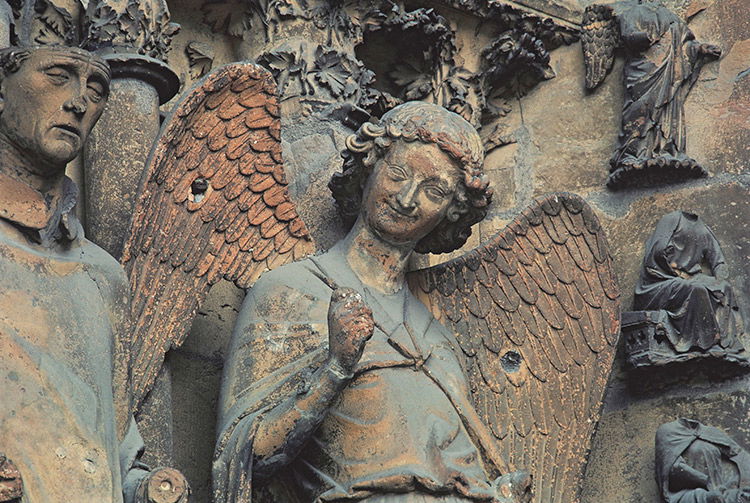
After Reims, a further six medieval cathedrals were laid waste: Meuchlen (Malines; 1914), Ypres (1914, 1915), Cambrai (1917), St Quentin (1917), Arras (1918) and Noyon (1918). The national cathedral of Nôtre Dame also suffered surface damage following an isolated Zeppelin raid on Paris in January 1916. In addition, the soaring abbey church of St Jean de Vignes near Soissons, a treasure house of later medieval decorative art including, as archaeological fragments have shown, a scheme of stained glass to rival Chartres, which had withstood the iconoclasm of the Huguenots and Napoleonic requisition, lost all but the shell of its west front. After the allies adopted its twin towers as a reconnaissance post, the abbey church of Mont St Eloi, near Arras, was projected into the heart of battle. By 1917 the site of the seventh-century abbey had been razed, with only the shards of its classical towers reaching above the rubble. The basilica of St Remi at Reims, crucible of French Christianity, founded to commemorate the conversion of Clovis, who in 496 became the first king to unite the Franks, was badly scarred, although its richly carved Romanesque nave endured.
The sheer scale of these churches, including some of the longest naves and tallest steeples and towers to survive from the Middle Ages, made them the most conspicuous of cultural casualties, yet much secular medieval architecture was also lost. Consumed by fire in the first days of the war, the University Library at Leuven (Louvain) was itself a fine, classical building, but it contained a collection of medieval manuscripts and incunabula (books printed before 1500) of great value: all were lost. Ypres' Lakenhalle (Cloth Hall) may have been the grandest, but many other civic, commercial and domestic buildings were obliterated in the densely developed streets not only of Ypres but also Liège, Mechlen, Reims, Arras and St Quentin. Given the powerful regional identities – the Duchy of Burgundy on the one hand, the wealth of the Flemish wool towns on the other – which had defined the design of these buildings and shaped their distinctive, decorative schemes, it might be said that an entire cultural milieu had been effaced.
Such widespread destruction of medieval heritage was unprecedented in the modern era. As the French press ruefully observed, even their Revolution – powered by a radical secularism – had not seen the razing of so many ancient sites. Not since the 16th-century Wars of Religion had churches in a whole chain of regional capitals suffered in such a way. It also represented a new departure in modern warfare because, as the conflict intensified, these medieval landmarks were made the deliberate target of offensive action. In this respect, the attack on Reims represented a turning point. The early damage wrought by the invasion force had been largely collateral. At Reims, however, the Germans fired on the cathedral. Earlier, on first entering the city, they had established a temporary encampment in the Place du Parvis but, as the allied counterattack began, they had withdrawn to a strat-egic position to the north to concentrate their fire on the centre of the city.
Thereafter, the great cathedrals and other medieval landmarks were targeted right along the Front. Shells did not stray towards Ypres, Meuchlen, Cambrai, St Quentin and Sailly: they were aimed. St Quentin was set alight in 1917. Noyon's interior was stripped and the pipes of its organ cut down for use as bands for shell cases. Although it had endured during some of the most intense barrages, in the autumn of 1918 the retreating Germans filled the piers and vaults of Arras cathedral with explosive charges. It would be wrong to regard the defacement and destruction of landmarks as wholly one-sided. The Allied forces were not slow to exploit the strategic benefits of these sites and were equally dispassionate in seizing the offensive advantage in their destruction: at Mont St Eloi, it was their own shelling that finally put paid to the remains of the church, so that what remained of its ridge-top position could not be turned against them by the enemy.
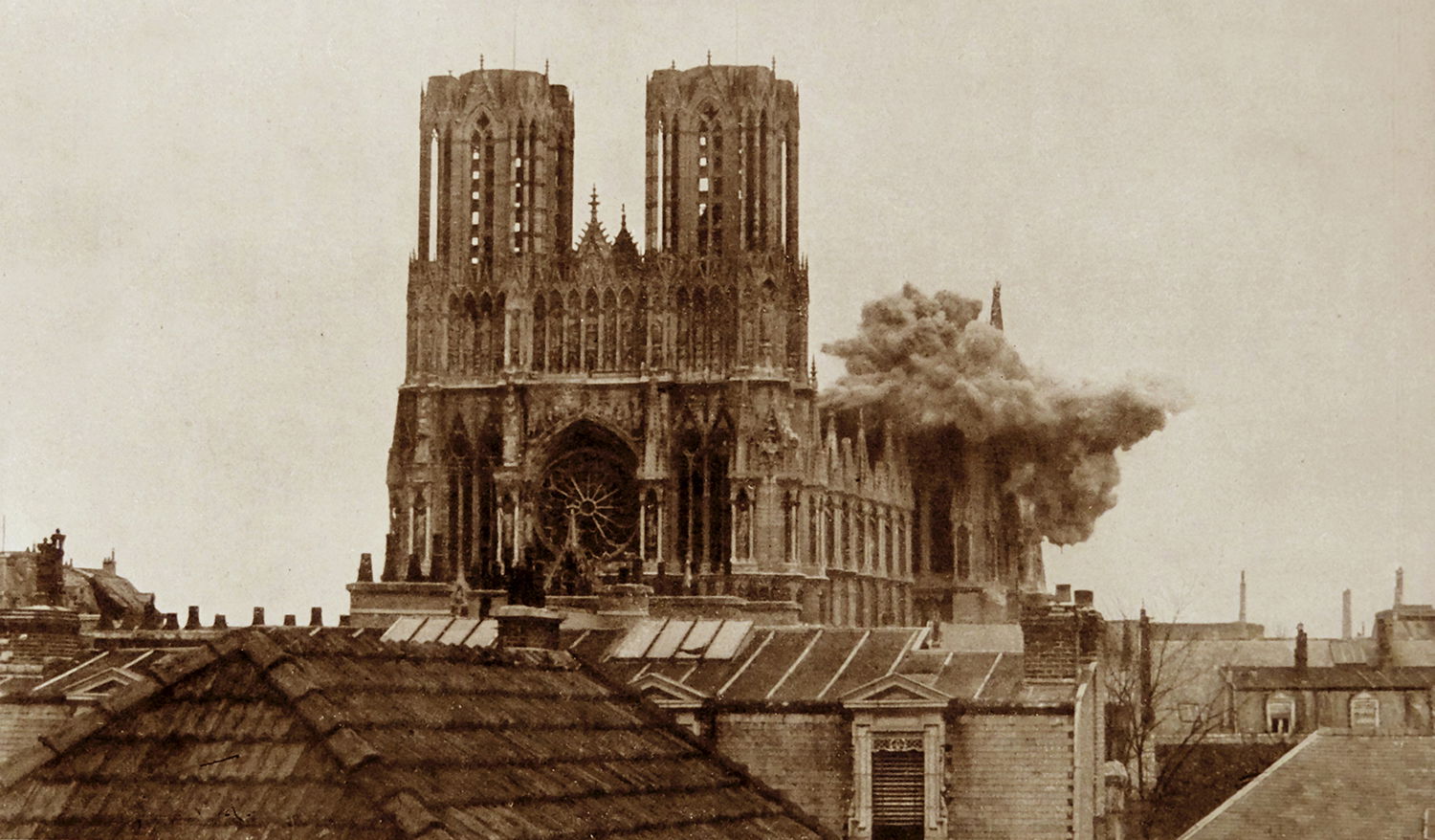
The targeting of cultural heritage represented a conscious assault on national identity, marking a growing recognition that this, just as much as casualties, defeats and retreats of the men in arms, could directly diminish morale. The medieval landmarks of Flanders and the industrial north of France were charged with a particular symbolic power, as they pointed to the prosperity and determined independence of the region in earlier generations. One of the key legacies of the conflict was its template for Total War, carrying the fight from the battlefield into the heart of the civil community. That such weapons as the aerial bombardment of civilian populations secured a permanent place in post-1918 armoury is all too familiar. Perhaps less so is the fact that the targeting of cultural assets became – and continues to be – a tool favoured by any force on the offensive. Although in the wake of the war the use of aerial bombardment was debated by the recent and future protagonists at the diplomatic table, notably at the Washington Conference of November 1921 to February 1922, no watertight convention has ever emerged.
The tit-for-tat attacks on the medieval cities of central and southern England – Bristol and Coventry in 1941, the Baedeker raids on Bath and Exeter in 1942 and southern Germany (Hamburg, Mainz and Dresden) – are well known. Less prominent are the medieval losses of our own times: the ruin, in 1993-4, of the ancient Bosnian city of Mostar and its Old Bridge, for so long the symbol of its prosperous past; the Taliban's blasting of the sixth-century Buddhas of Bamiyan in 2001; the irreparable damage to many early medieval sites in Iraq, most notoriously, the Minaret al-Malwiya at Samarra in 2005, an attack that recalls the fate of Mont St Eloi, since it was made the target of insurgents after US forces allegedly used it as a sniper post; and the losses of the last 12 months in Syria, which include a tower of the 12th-century crusader castle, Crac de Chevaliers, and the minaret of the Great Mosque of Aleppo.
The ruin of ancient landmarks on the Western Front captured public attention as much as the lengthening casualty lists. The jagged remains of towers and frontages conveyed the apocalyptic power of constant bombardment and still photographs in the printed press and, in time, newsreel footage, carried them across Europe. Images of the heaped rubble that lined the nave at Reims were widely syndicated. In England a public exhibition was hurried into London's Leicester Galleries showing 'the glory that was Reims'. Even in the heat of its commitments on the Marne, the Third Republic issued an official response to the assault on Reims, inviting the wider world to share in its outrage, a 'revolting act of vandalism, which … robs the whole of humanity of an irreplaceable piece of its artistic heritage'. Robust justification and counter allegations of hypocrisy from the German authorities ensured that another pan-European dispute sparked and stuttered through the wires of the international press. The ruin of buildings made ideal visual copy for the rapidly expanding news media. Pathé presented British picture houses with a reel showing the shattered remnants of Arras in 1917, which many billeted Tommies had come to know well.
Before the Armistice, postcard views of devastated churches were already in circulation. Their effect was not only awe and shock, but to make these great medieval sites, always a source of antiquarian fascination and regional pride, a focal point for the national interest. It is not that they stirred a more immediate or deeper emotional response than the spectacle of devastated cities and their dead or displaced citizens on the Franco-Belgian border, but they fostered a different one, a sharpening sense of the historic identity that was under attack, which also held the key to their defence. People – civilians and soldiers, whether resting or returning up the line – were drawn to these sites more than any others where the shells had rained and they did so while the threat of bombardment continued and when dislodged statues, pillars and vaulting must have made their visits perilous. One such was George Brooker, serving with the Royal Army Service Corps, who picked his way through the shattered nave at Arras one day in 1917. He gathered up the shards of Gothic glass beneath his boots and enclosed them in an improvised frame of wooden scraps. Fortunately, George survived to the Armistice and his stained-glass entered the collection of the Imperial War Museum.
*
The attention given to the great cathedrals and abbey churches also engendered a level of spirituality, which some had considered lacking in the early stages of the war. Public worship and private devotion in these spaces surged, even among the rubble. Church leaders, roused into guiding the public response, used the fragility of their most ancient places of worship to reinvigorate intercession. Cardinal Louis-Henri-Joseph Luçon, Archbishop of Reims, performed the Stations of the Cross daily, picking his way around the fallen vault of the nave. In England parallel efforts were carried forward by Canterbury, York and the senior bishops, in which the historic resonance of their great churches was self-consciously harnessed to the imperatives of the Home Front. National Days of Intercession, first tried during the Boer War, called the public into these ancient places of worship; at Salisbury and Exeter Cathedrals and Westminster Abbey local people were reminded of the bishops' wish that everyone pause and enter their churches for prayer at noon each day. At a time when troops from across the Empire were passing through many cities and towns, it would appear the antiquity of these places spoke to those with little first-hand knowledge of the Old Country they served. After a visit to Exeter Cathedral, Brigadier General Herbert Hart, commander of New Zealand's Second Infantry Brigade, reflected in a diary entry of 15 May 1918: 'All these places are most closely connected with the historical development of the country during the last nine centuries and are intensely interesting.'
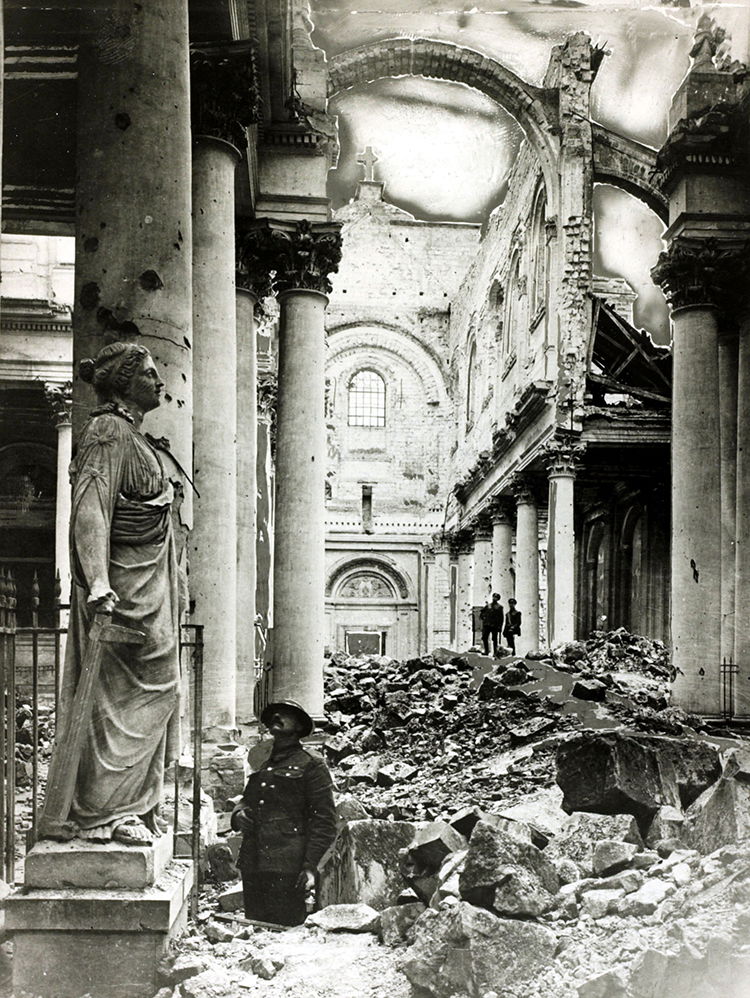
By the war's end, it does seem possible to trace a distinct turn in public attitudes towards these medieval landmarks. In Belgium and France there was an almost instinctive impulse to make the shells of their medieval churches public memorials. As such, they became the priority for reconstruction. In April 1919 the Bloc National determined that all ancient landmarks were to be returned to their prewar condition. Work began within months, funded, at least for the medium term, by German reparation payments; in the immediate term it was carried forward by German labour; it was prisoners of war that began the early work at Arras. At least in France, in the first months of the peace, the work to recover the lost cathedrals was used explicitly to advance the case for German war guilt: the historian Maurice Andrieux published a study of Reims in 1919, which he subtitled un crime allemand.
The priority attached to the work of reconstruction was reinforced by an early (and common) vision among the republic's leaders that the landmarks at the centre of these cities bearing battle honours should serve as the nation's memorial. In the first postwar months there was no movement to raise a secular memorial and the dominant impulse was to (re)invest in the notion of a national church. Reims Cathedral was designated the first among equals, for its unrivalled links to the nation's past. Also, as the first to fall, for both government and people its fate had focused the threat to the cultural and historical identity of France. Restored, the cathedral not only acquired the sacral status of a shrine to the Republic's sacrifice but was also raised as a symbol of their secular, political agenda for continental peace. It was the summation of its role since September 1914 that President de Gaulle and Chancellor Adenauer conducted their act of Franco-German reconciliation in the restored, 13th-century crossing on 8 July 1962.
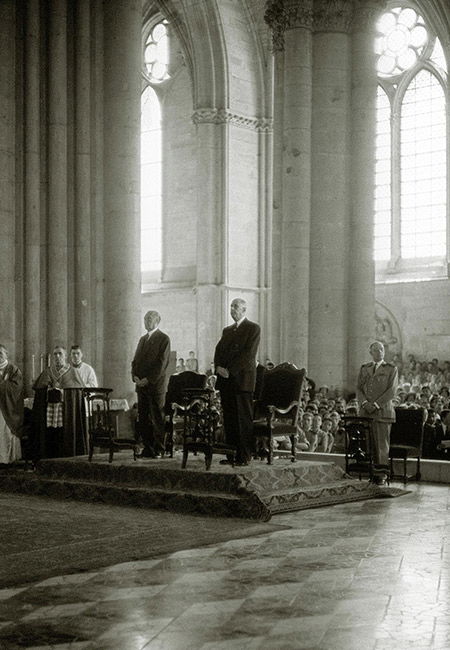
In England, in the wake of the Armistice, the great cathedrals, minsters and abbeys, as a continuation of their recent role in public intercession, were upheld as the natural focus for national commemoration. It was Wren's masterpiece, St Paul's, that witnessed the royal service of thanksgiving, but, like their French and Belgian counterparts, the prelates and clergy of the senior sees also harnessed the palpable historical identity of their medieval churches to the widespread impulse for mourning. Away from the spirit of thanksgiving that swept the capital – causing damage to the plinth of Nelson's Column on the night of the Armistice – requiems were conducted in the provincial cathedrals. Notable figures were honoured, in special services, with Westminster Abbey electing to celebrate the US wartime ambassador, Walter Hines Page. There was also a response to the public's reaching out for meaningful commemoration. In a conscious recall of medieval practice, and for the first time since the Reformation, libri vitae were inscribed. Regimental colours were accepted into ancient chantry chapels and a number of makeshift wooden crosses recovered from the battlefields and chapels, such as that of St Michael, Salisbury, were re-dedicated to the memory of the fallen.
*
As they channelled public mourning and public memory, offering an historical framework in which the experience of the war might, in the fullness of time, be more comfortably held, it would seem that the status of these medieval landmarks ineluctably changed. In England, as much as France, they were transposed from the focus of provincial pride to treasures of national significance. One expression of this change, which did much to secure their new-won status, was the postwar explosion in heritage tourism. Directed towards their best-known medieval landmarks to assuage their collective shock and private grief and to articulate an impulse to memorialise, the French and English publics renewed their relationship with their national past. Those whose business was travel were swift to recognise a shift in social behaviour. The Chemin de Fer du Nord did not wait for the new Reims to be finished before it invested in a romantic poster image of the cath-edral to call citizens to see their national war memorial. England's largest railway company, Great Western (GWR), embarked on its own promotion in 1924: recruiting academic medievalists – Montague Rhodes (MR) James, provost of Eton and King's College, Cambridge, and Sir Charles Oman, Oxford's Chichele Professor, and launching a trio of guidebooks to the cathedrals, abbeys and castles of the region served by GWR. Announced by a poster campaign to rival the Art Deco imagery of the French railway companies, the guides called on their customers to practice a new kind of touring, sober and reflective, 'not to be unloaded for ten minutes from a charabanc', as the guide admonished, but to pause amid 'these precious monuments of English piety'.
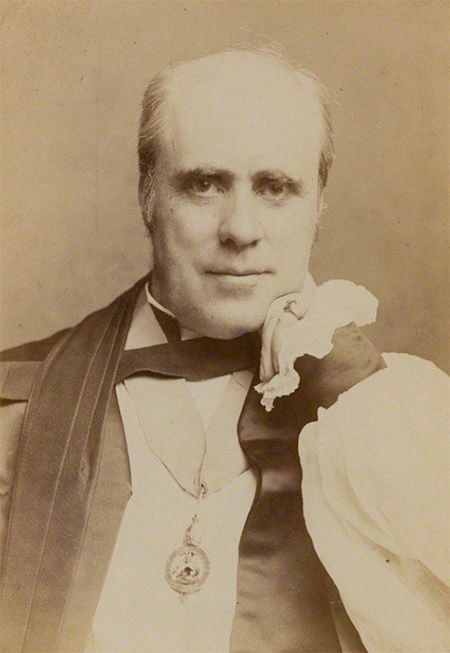
The connection with the war and the common memory of it was made explicit. Archbishop Randall Davidson of Canterbury, architect of the wartime national days of intercession, was invited by GWR chairman, Viscount Churchill, to introduce the guides: 'You will render a wonderful service to the English people', he wrote in a letter reproduced as a frontispiece, 'if you will help them to realise the sacred heritage which is ours.' The shadow of the war reached into the account of almost every site, none more so than in Salisbury, whose 'surpassing beauty' was a monument to the absence of 'foreign influence'. Cathedrals, the first guide, was an immediate best-seller: 30,000 copies were sold in just eight weeks. The company's conviction that it was the memory of England's past and, in particular, its medieval past, which was most likely to stir the public mood became the guiding principle of its marketing. Even as the Cathedrals guide was in press, ten 'star' class locomotives were given the names of England's medieval abbeys; in 1923 a new 'cathedrals' class was contemplated: the plan changed but what became the 'kings' class still commemorated the succession of monarchy from the Conquest. Medievalism was especially strong in their merchandise for children: a series of jigsaws produced by the toy company Chad Valley not only celebrated cathedrals and castles of the GWR region but also scenes from the company's growing sense of a 'grand narrative' of English history: 'the Romans at Caerleon', 'King Arthur on Dartmoor' and 'the Vikings landing at St Ives'.
The GWR outlook spread quickly and widely. Copycat guides appeared almost overnight: J.M. Dent's popular Cathedrals, Abbeys and Famous Churches series was on the same station bookstalls scarcely six months later. Batsford began its colourful series of guides to architectural and topographical heritage in 1930. In what was perhaps the ultimate expression of popular interest, Wills printed their first collector's series of cigarette cards featuring England's cathedrals in 1933. Even academics responded: George Coulton, a controversial medievalist, embarked on his epic Five Centuries of Religion in 1923, a five-volume undertaking, which he completed, by curious symmetry, in the midst of the London Blitz. At the same time the Office of Works accelerated the programme of conservation which had been promulgated at the passing of the Ancient Monuments Act in 1913 but had been arrested for almost a decade.
As we debate the many modernising trends that may be traced to the cataclysms of 1914-18, we should also acknowledge that from that deluge there also flowed a new outlook on humanity's ancient achievements.
James G. Clark is Professor of History at the University of Exeter. This article first appeared in the April 2015 issue of History Today.